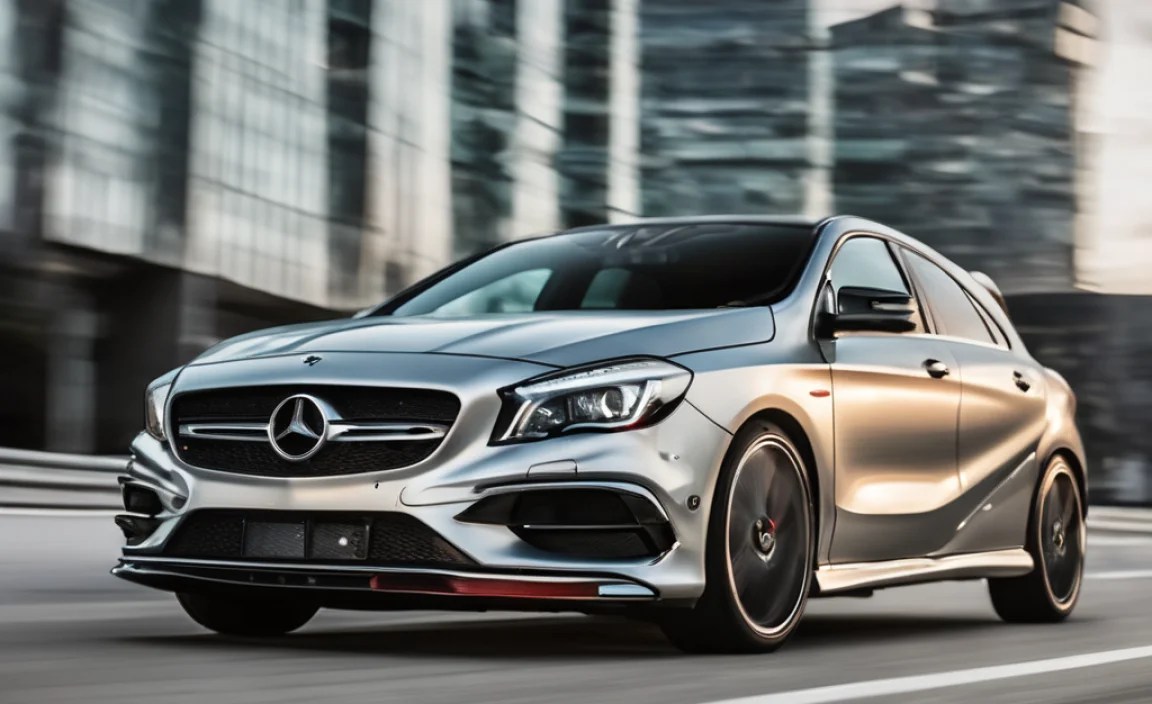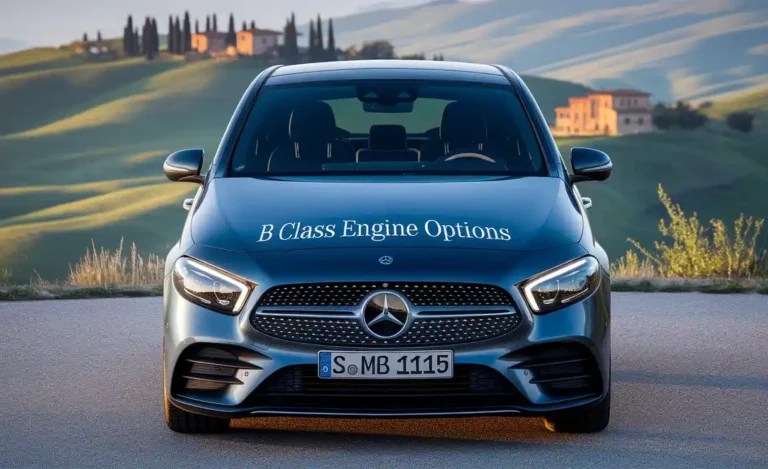B Class 7 Speed DCT: Ultimate Performance Perfected
The B Class 7 Speed DCT delivers exceptional performance through its dual-clutch technology, offering swift, smooth shifts for a dynamic driving experience. It perfects agility and efficiency, making your Mercedes-Benz feel responsive and fun.
Ever wondered what makes your Mercedes-Benz “B Class” feel so quick and seamless when moving through the gears? The secret often lies in its advanced transmission, specifically the 7-Speed DCT. This isn’t just any gearbox; it’s a sophisticated piece of engineering designed to give you exhilarating performance with impressive efficiency. If you’ve experienced those lightning-fast shifts and smooth power delivery, you’ve felt the magic of the Dual-Clutch Transmission (DCT). We’re here to break down exactly what makes this transmission so special and how it perfects the driving experience in your Mercedes-Benz B Class.
In this guide, we’ll demystify the 7-Speed DCT, exploring its core technology, the benefits it brings to your drive, and what makes it a benchmark in automotive performance. You’ll gain a clear understanding of the engineering marvel beneath the hood and appreciate the refined driving dynamics it provides.
Understanding the 7-Speed DCT: The Heart of Performance

At its core, the 7-Speed DCT is an intelligent fusion of automatic and manual transmission technologies. Unlike a traditional automatic that uses a torque converter, the DCT employs two separate clutches. One clutch controls the odd-numbered gears (1, 3, 5, 7), while the other manages the even-numbered gears (2, 4, 6) and reverse. This ingenious setup allows the transmission to pre-select the next gear. When a shift is imminent, one clutch disengages while the other engages almost instantaneously, ensuring minimal interruption in power delivery.
This dual-clutch system is the key to its performance. Imagine shifting gears on a bicycle; you anticipate the terrain and select the next gear before you truly need it. The DCT does this automatically and with incredible speed. This means that when you accelerate, the power flows almost uninterruptedly from the engine to the wheels, resulting in smoother acceleration and a more engaging driving experience. The “7-speed” part simply refers to the number of forward gears it has, offering a wider range for optimal engine performance and fuel efficiency across various driving conditions.
How Does the 7-Speed DCT Work? A Closer Look

Let’s peel back the layers of the 7-Speed DCT to understand its inner workings. The system operates with two independent clutch assemblies, often referred to as “clutch packs.”
- Clutch Pack 1: This pack typically manages gears 1, 3, 5, and 7.
- Clutch Pack 2: This pack usually handles gears 2, 4, 6, and Reverse.
When you’re driving in a particular gear, say 3rd gear, Clutch Pack 1 is engaged, and the system has already anticipated and pre-selected the next logical gear, which would be 4th gear, and is holding it ready within Clutch Pack 2. When the optimal moment for a shift arrives (based on engine speed, throttle input, and vehicle speed), Clutch Pack 1 disengages from 3rd gear, and simultaneously, Clutch Pack 2 engages 4th gear. This happens in milliseconds, creating a seamless transition that feels more like a continuous surge of power rather than distinct gear changes.
The transmission control unit (TCU), essentially the brain of the operation, constantly monitors driving conditions and driver inputs to make these shift decisions. It uses complex algorithms to determine the optimal gear for acceleration, economy, or braking, ensuring the drive is always responsive and efficient.
Key Benefits of the 7-Speed DCT

The adoption of the 7-Speed DCT in Mercedes-Benz B Class vehicles brings a host of advantages that significantly enhance the driving experience. These benefits are not just about raw speed; they encompass efficiency, refinement, and an overall more connected feel to the road.
Unparalleled Shift Speed and Smoothness
The most noticeable benefit is the speed and smoothness of gear changes. Because the next gear is pre-selected, shifts are almost instantaneous. This minimizes the power interruption typically felt in traditional automatic transmissions, leading to significantly crisper acceleration and a more dynamic feel. For drivers who appreciate agility and responsiveness, this is a game-changer.
Enhanced Performance and Acceleration
The seamless power delivery from the DCT directly translates to quicker acceleration times. With less time spent between gears, the engine can maintain its optimal power band more effectively. This means your B Class can reach higher speeds faster, making overtakes more confident and exhilarating. It’s a critical component in achieving that signature Mercedes-Benz blend of comfort and spirited performance.
Improved Fuel Efficiency
While performance is a key driver, efficiency is equally important. The 7-Speed DCT’s ability to pair with a wider range of gear ratios allows the engine to operate at its most efficient RPM for a given speed. For instance, on the highway, it can engage a taller, lower-RPM gear, saving fuel. The precise and rapid shifts also mean that the engine spends less time out of its most efficient operating range, contributing to better overall fuel economy compared to older automatic technologies.
Agility and Driving Dynamics
The DCT contributes to the overall feel of agility. The precise control over gear selection allows the car to feel more nimble and responsive to driver inputs. Whether you’re navigating city streets or enjoying a winding country road, the transmission works harmoniously with the engine and chassis to provide an engaging and confident driving experience. It feels more connected, like the car is truly an extension of your will.
Versatility in Driving Modes
Modern DCTs, including those in Mercedes-Benz vehicles, are often integrated with selectable driving modes (e.g., Comfort, Sport, Eco). In ‘Comfort’ mode, the transmission prioritizes smooth, unobtrusive shifts for relaxed driving. Switch to ‘Sport’ mode, and the TCU recalibrates its shift strategy, holding gears longer, downshifting more aggressively, and executing shifts with an even sportier feel to maximize performance and driver engagement.
DCT vs. Traditional Automatic vs. Manual Transmissions

To truly appreciate the 7-Speed DCT, it’s helpful to compare it with other common transmission types. Each has its strengths and weaknesses, but the DCT often strikes an excellent balance.
| Feature | 7-Speed DCT | Traditional Automatic (Torque Converter) | Manual Transmission |
|---|---|---|---|
| Shift Speed | Extremely fast, near-instantaneous | Slower, with noticeable power interruption | Dependent on driver skill, can be fast but requires effort |
| Smoothness | Very smooth, especially at higher speeds | Can be very smooth, but sometimes hesitant | Can be jerky if not executed perfectly |
| Performance Feel | Sporty, direct, engaging | Comfort-oriented, refined | Most direct connection to the engine, highly engaging |
| Fuel Efficiency | Excellent, often better than automatics | Good, but can be less efficient than DCT or manual | Potentially best, but depends heavily on driver |
| Complexity | High; sophisticated control systems | High; complex hydraulics and planetary gears | Relatively simple mechanical linkage |
| Driver Engagement | Moderate; offers paddle shifters for manual control | Low; primarily automated driving | High; requires full driver input and skill |
As you can see from the table, the 7-Speed DCT, particularly in a luxury performance context like Mercedes-Benz, excels by providing the best of both worlds: the rapid, engaging shifts desired by enthusiasts and the seamless, efficient operation expected by luxury car owners. Its complexity serves the purpose of providing a superior driving experience that is both sporty and refined.
The “B” in B Class and its Transmission Connection

The “B” in Mercedes-Benz B Class historically denotes a compact, versatile vehicle designed for modern lifestyles. While the B Class is not typically an AMG high-performance model, Mercedes-Benz engineers integrate advanced technologies, including the 7-Speed DCT, to imbue even its more practical models with a sense of agility and responsiveness. This ensures that whether you’re commuting, on a family outing, or enjoying a spirited drive, the driving experience remains refined and engaging.
The integration of the 7-Speed DCT in the B Class is a testament to Mercedes-Benz’s philosophy of providing a premium experience across its entire model range. It means you don’t have to step up to the highest-tier models to enjoy cutting-edge transmission technology that enhances performance, efficiency, and driving pleasure. The powertrain is precisely tuned to suit the character of the B Class, offering a balance of comfort, economy, and dynamic capability.
Maintaining Your 7-Speed DCT
While the 7-Speed DCT is a robust and advanced piece of engineering, like any complex system, it requires proper maintenance to ensure its longevity and optimal performance. Regular servicing is key to avoiding potential issues and keeping that precise, smooth shifting behavior intact.
Fluid Changes: The Lifeline of the Transmission
The transmission fluid is crucial. It lubricates moving parts, cools the transmission, and aids in hydraulic pressure for clutch operation and gear shifting. Over time, this fluid can degrade, losing its effectiveness. Mercedes-Benz typically specifies a service interval for transmission fluid and filter changes. It’s vital to adhere to these recommendations, usually found in your owner’s manual.
Importance of Genuine Parts: Always ensure that your service provider uses genuine Mercedes-Benz transmission fluid and filters. These are specifically formulated to meet the exact specifications of your vehicle’s DCT, ensuring compatibility and optimal performance. Using aftermarket fluids can lead to transmission problems, void warranties, and compromise performance.
DIY Checks and When to Seek Professional Help
While complex internal repairs are best left to certified technicians, there are a few things you can keep an eye on:
- Fluid Level and Condition: Though often sealed and requiring specialized tools for checking, if accessible, observe the fluid for any signs of leaks or unusual smell (like burnt toast), which can indicate a problem.
- Shifting Performance: Pay attention to how the transmission behaves. If you notice any harsh shifting, hesitation, slipping between gears, or unusual noises, it’s time to consult a professional immediately.
- Warning Lights: If the transmission warning light illuminates on your dashboard, do not ignore it. This indicates a fault that needs prompt attention.
For any specific maintenance tasks or suspected issues, it’s always recommendable to consult with a qualified Mercedes-Benz service centre or a mechanic specializing in European vehicles. They have the necessary specialized tools, diagnostic equipment, and expertise to accurately diagnose and repair any transmission concerns.
The Future of Mercedes-Benz Transmissions
Mercedes-Benz continues to innovate in transmission technology. While the 7-Speed DCT has been a staple and a reason for performance excellence, the brand is also exploring and implementing even more advanced systems, including expanded use of 9-speed automatics (9G-TRONIC) and looking towards electrification’s impact on gearbox design. However, the principles of efficiency, responsiveness, and smoothness that made the 7-Speed DCT so successful remain the guiding stars for all future Mercedes-Benz transmissions.
The continuous evolution ensures that Mercedes-Benz vehicles remain at the forefront of automotive engineering, offering drivers increasingly sophisticated and enjoyable driving experiences. The focus remains on delivering that hallmark Mercedes-Benz blend of comfort, performance, and advanced technology, making every drive a refined journey. Learning about the 7-Speed DCT is a fantastic way to understand the engineering that makes this possible.
Conclusion: Perfected Performance in Every Drive
The 7-Speed DCT is a remarkable piece of automotive engineering that has dramatically shaped the driving dynamics of modern vehicles, including the Mercedes-Benz B Class. By utilizing dual-clutch technology, it achieves an unparalleled blend of rapid, seamless gear changes, exhilarating acceleration, and impressive fuel efficiency. This transmission transforms every drive, making it more engaging, responsive, and refined.
Understanding how your 7-Speed DCT works not only deepens your appreciation for your Mercedes-Benz but also empowers you to maintain it properly. Adhering to the recommended service intervals and using genuine parts are the best ways to ensure this sophisticated system continues to deliver its perfect performance for years to come. The technological advancements embodied in the 7-Speed DCT are a clear indicator of Mercedes-Benz’s commitment to innovation and delivering an exceptional driving experience across its entire fleet. So, the next time you feel that instant surge of power or a perfectly smooth shift, you’ll know it’s the 7-Speed DCT perfecting your drive.
Frequently Asked Questions (FAQ)
1. What does DCT stand for in my Mercedes-Benz B Class?
DCT stands for Dual-Clutch Transmission. It’s an advanced type of automatic transmission that uses two separate clutches to shift gears much faster and smoother than traditional automatics.
2. Is the 7-Speed DCT better than a traditional automatic transmission?
For performance and engagement, yes, many drivers find the 7-Speed DCT superior due to its quicker, more direct shifts. It often offers better fuel efficiency too. Traditional automatics can sometimes offer a smoother, more refined experience, particularly at low speeds, but the gap has narrowed significantly with modern DCTs.
3. How do I know if my Mercedes-Benz B Class has a 7-Speed DCT?
You can usually tell by checking your vehicle’s specifications, owner’s manual, or VIN decoder. If your car shifts gears very rapidly and without much interruption of power, it’s likely a DCT. For B Class models from certain years, this transmission was standard or a common option.
4. Can I drive my car aggressively with a 7-Speed DCT?
Absolutely. The 7-Speed DCT is designed for performance and responsiveness. Using paddle shifters (if equipped) or sport modes will allow you to take full advantage of its capabilities for spirited driving.
5. What is the typical maintenance schedule for a 7-Speed DCT?
Mercedes-Benz typically recommends transmission fluid and filter changes around every 40,000 to 60,000 miles, but always consult your owner’s manual for the exact schedule for your specific model and year. Regular fluid changes are key to its longevity.
6. Are DCTs more expensive to repair than traditional automatics?
Generally, DCTs are more complex and can be more expensive to repair than simpler automatic transmissions due to their intricate design and the precision required for servicing. This is why adhering to the maintenance schedule is crucial.
7. Can I shift my 7-Speed DCT manually?
Yes, most 7-Speed DCTs in Mercedes-Benz vehicles can be operated in a manual mode, usually via paddle shifters on the steering wheel or by moving the gear selector to a manual setting. This allows you to select gears yourself for more control.






